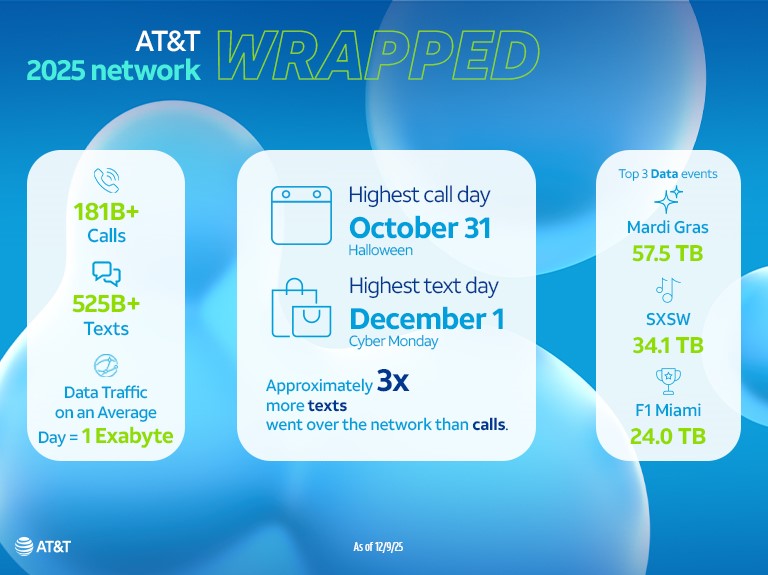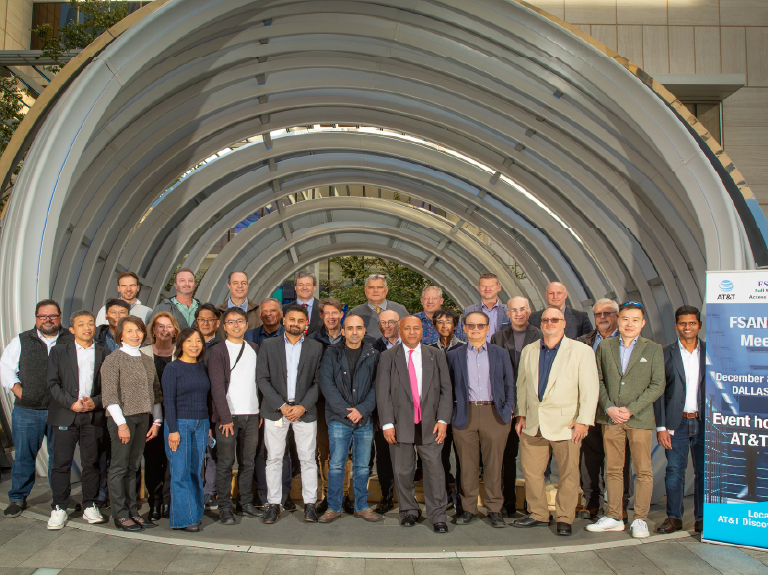I believe we’re at another inflection point in the global telecom industry. And for those of us in this industry, it is a moment where we’re coming together to co-create new connectivity experiences through standardized Open APIs.
Today, our network serves over 100 million U.S. customers and nearly 2.5 million businesses. We have the largest wireless network in North America1, and we are the nation’s largest fiber internet provider2. We continue to expand 5G coverage and scale our standalone 5G. We recently launched our new AT&T Internet Air home fixed wireless service and collaborated with AST SpaceMobile to achieve a world-first smartphone-to-satellite phone call.
Getting to this point with our network has been the result of multi-year strategies in areas you’ve come to expect from a network operator: infrastructure investments, smart operations, innovation, and collaboration. The work in these areas continues, as it always will.
Today, AT&T’s network is open, virtualized and software defined. Our 5G network runs on a cloud-based platform. We have commercially launched standalone 5G and 5G edge zones that could bring users closer to the network. These are all independent components that, when brought together, provide opportunity for monetization, improved customer experience and yet another wave of innovation via open APIs.
Moving at Software’s Speed
But, as exciting as our investments in fiber and 5G are, I’m also excited about another way we are building the network. Operators are taking steps to enable more digital distribution, provisioning, and consumption of network capabilities.
This isn’t the first time we’ve exposed network APIs to developers. The industry has talked about this since 4G. But what is unique about it this time is that the programmable capabilities of our network have increased significantly, and our network is becoming one where connectivity solutions will be increasingly digital and self-service in nature.
You can find customer expectations for a digital-first, on-demand experience in most aspects of life: the shows we stream, the ability to connect over a webcam and the ability to detect and counteract cyberattacks. We believe that advanced network capabilities should also meet this expectation.
Our next step will be to embed capabilities that will be exposed by and made accessible through network APIs to businesses and developers – all without need for network expertise on their part or additional infrastructure spend on ours. They can harness the power of AT&T’s network without needing a consultation or background in network architecture.
The innovations this effort will make possible are very exciting! We are doing this because we believe that to fully unlock the value of 5G, we must make the network an accessible, fundamental part of developer projects rather than something to bypass.
As my colleague and head of our network, Chris Sambar, recently stated – we believe the next killer app is the network. When some hear this, they might gravitate to faster speeds or more coverage. Yes, those are an important part of this. But, when I channel this network as the next killer app, I’m talking about developers and businesses tapping into an open network as they create the next service, product or experience.
For true growth (aka monetization) of the network to take place, we must expose more of it through reusable open network APIs, and it needs to be a simple process. Without simplicity and interoperability, this won’t take off like needed to tap into creating tomorrow’s connected experiences and new products and services.
Modernizing to monetizing the network
If it seems timely that we are opening the AT&T network via APIs as we are pushing into what we believe to be a new era of connectivity, that’s the idea!
And AT&T is not new to APIs. Working with APIs is inherent to software interoperability. For years, AT&T has been a leader in this space.
- Introduction of new products and services: Since the launch of the iPhone in 2007, our work in APIs has also helped bring eSIM to consumer devices. APIs are also at work in our network to provision our connected car and IoT subscribers and enable services for them. APIs enabled AT&T NumberSync which provides customers a seamless ‘one-number’ service for cellular-connected Apple, Samsung, and Google wearables. We’ve also enabled cable operator members of the National Content & Technology Cooperative to launch MVNO services.
- Optimizing business processes: Our APIs have improved our operational efficiencies and our ability to onboard new customers.
We view these and other accomplishments as the foundations for our next big act. What are the possibilities? Here are just some examples:
- Security solutions: we are able to offer unique value as an operator with unmatched field of view of network traffic. When we add machine learning on top of this view, we’re able to offer faster, more effective threat and anomaly detection and remediation. This will allow customers to operate with more confidence in an increasingly digital landscape. To go even further, customers will be able to benefit from security applied at the network layer rather than as an over-the-top additive solution. This means that on our network, you can filter traffic, detect threats, and execute security controls all before data reaches your own network.
- Network experiences: we are developing solutions to give customers the ability to customize a network experience to suit their needs. This could enable even greater network performance for things like security services where high quality video monitoring is mission critical.
- Messaging experiences: for businesses that engage their customers over text, we are building a new cloud-based platform to host their messaging capabilities. Our API-first approach will reduce barriers to onboard their services and increase the level of support we can offer them.
We want to place the power of the network in the hands of developer communities, the people closest to the use cases customers have been dreaming up since 5G was barely on the horizon. We plan to scale our capabilities by exposing them as APIs on various hyperscaler and aggregator platforms. These are places already familiar to and trusted by developers.
The future is open
For years, AT&T’s technology strategy has involved open architectures and adhering and contributing to industry standards. More than a decade ago, AT&T began a journey to virtualize our network. The idea had always been to move toward an open architecture, where the entire industry can benefit.
The connectivity ecosystem has benefitted from interoperability across networks and carriers. Why should it be any different for developers?
More participation in collaborative efforts is a good thing. And so, we acted on this conviction through such things as participation in open-source initiatives. We also engineered our own telco-grade Network Cloud software which we sold to Microsoft.
Our prior experience and existing model for monetizing our network innovations are why we are so optimistic about this.
AT&T’s approach will be a combination of wholesale and indirect paths to market where network services will be available as cloud-native solutions.
We are also developing AI capabilities and aiming them at what the network can produce for customers. This is exciting, because of the unique value we have in the scale of the data we can train AI upon.
The next phase is here
The bottom line is that we are building a platform for differentiation for those whose data rides our network. In the tradition of AT&T Labs, we’ve been hard at work proving the technical viability of the platform I’ve described here.
And we are not doing this alone. Serving up the network as a programmable service platform is an intentional effort we’re making in collaboration and with purposeful timing.
If you’d like to see some proof, I invite you to learn more about our participation in TM Forum’s Catalyst program, where we are collaborating with other technology and industry leaders to develop proofs-of-concept that would illustrate how this vision can be brought to life.
In collaboration with various organizations, we are working to develop and prove the technical viability of new network service capabilities:
- Creating an on-demand, highly secure, private 5G broadband connection between an enterprise application deployed in the cloud and a device
- Monitoring that connection through customer insights so that CSPs and their enterprise customers can confirm that their connectivity has been optimized
- Combining these two capabilities into a single offering available on hyperscaler portals as a cloud-native service so that developers don’t have to consult with network engineers in order to use it
Together, these show the promise to open new lines of business across the connectivity ecosystem not only by accelerating how customers can procure network services, but also by standardizing the way operators will make network capabilities available.
This open network future is coming fast, and I look forward in sharing more about how this looks in the coming weeks and months.
Read more Technology & Innovation news



